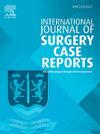Extracorporeal membrane oxygenation in patient with dilated cardiomyopathy: A case report
IF 0.6
Q4 SURGERY
引用次数: 0
Abstract
Introduction
Extracorporeal membrane oxygenation (ECMO) became a technique of respiratory and cardio respiratory assistance ensuring the oxygenation and the perfusion of the organs while waiting for the restoration of their functions. Critical care physicians should recognize early pathologies likely to progress rapidly to refractory cardiogenic shock and asystole.
Case presentation
A 29-year-old man known carrier of idiopathic dilated cardiomyopathy since 2017 presented with refractory cardiogenic shock after spinal anaesthesia for surgical treatment of a coccygeal fistula. The diagnosis of acute fulminant myocarditis toxic to anaesthetic products was suspected and he was supported after 24 h with an extracorporeal membrane oxygenation (ECMO) for cardiopulmonary support for 14 days with gradual improvement and successful weaning, the patient was extubated in three days and discharged from hospital after recovery from reanimation injuries.
Discussion
The occurrence of refractory cardiogenic shock in patients with dilated cardio myopathy may require the establishment of temporary ECMO for circulatory support as a bridge to long-term assistance, transplantation or recovery. In these emergency situations, ECMO is now the first circulatory assistance line and the patient must be referred as quickly as possible to a medical and surgical centre with the mastery of the implementation and monitoring of this complex technology. A refractory cardiogenic shock even in patients with dilated cardiomyopathy may require the establishment of temporary ECMO for circulatory support as a bridge to long-term assistance, transplantation or recovery.
Conclusion
The long-term prognosis of these patients who received an ECMO is not known. However, without circulatory support, the survival rate is almost nil.
求助全文
约1分钟内获得全文
求助全文
来源期刊
CiteScore
1.10
自引率
0.00%
发文量
1116
审稿时长
46 days

 求助内容:
求助内容: 应助结果提醒方式:
应助结果提醒方式:


